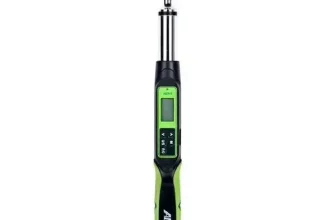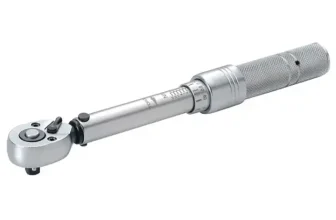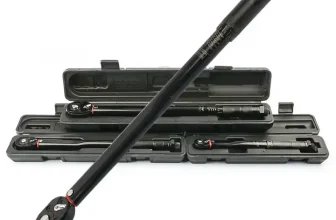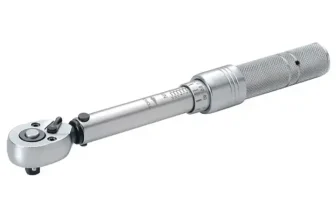A torque wrench and a breaker bar are two common tools often found in the toolboxes of mechanics and DIY enthusiasts. The torque wrench, as the name implies, is a tool specifically designed to apply a certain amount of torque (force) to a fastener such as a nut or a bolt. This tool is unique in that it allows one to precisely control and measure the amount of force applied, ensuring that the fastener is neither too loose nor too tight.
On the other hand, a breaker bar, sometimes referred to as a cheater bar, is often employed to ‘break’ fasteners that are extremely tight or stuck. Its long length leverages the law of physics to create more torque than a standard socket wrench, allowing for greater force and loosening stubborn fasteners.
Together, these tools serve their unique purposes and complete a mechanic’s toolset. However, they are fundamentally different tools designed for different tasks. Are they interchangeable, though? This article aims to explore this query and discuss the implications of using a torque wrench as a breaker bar.
Purpose of the article
This article aims to explore the possibility and implications of using a torque wrench as a breaker bar in various mechanical projects. Many individuals, especially DIY enthusiasts, might ponder if these tools are interchangeable due to their similar appearance. To address this, we’ll delve into both tools’ characteristics, purposes, and the potential risks posed when misused. This discussion hopes to provide a better understanding about tool usage, emphasizing the importance of tool safety and efficiency in any task.
Understanding the Torque Wrench
Description and function of a torque wrench.
A torque wrench is a specialized tool used to apply a specific amount of torque, a measure of rotational force, to a nut or bolt. Conceived primarily for precision and consistency, it plays a significant role in ensuring that fasteners are tightened sufficiently to hold parts together without over-tightening, which can lead to the fastener or component being damaged.
Its mechanism is uniquely designed to measure and control the amount of force it applies, preventing over-tightening and ensuring the correct tension necessary for the joint. Each torque wrench is calibrated to deliver a range of torque values, allowing users to adjust it based on the specifications of the fastening task.
From automotive repair to aerospace and construction, torque wrenches are essential in any field requiring precise mechanical work. They are fundamental in ensuring threaded fasteners are secure and safe, providing accuracy that a regular wrench just can’t offer.
Different types of torque wrenches and their uses.
There are several types of torque wrenches, each with distinct characteristics and uses. The most common are the click-type, beam type, digital and dial type.
- Click-Type Torque Wrench: This is the most commonly used type. It ‘clicks’ when the user reaches the preset torque, thereby signaling them to stop applying force. This tool is ideal for a vast range of applications, particularly automotive repairs and maintenance tasks.
- Beam Type Torque Wrench: This relies on a simple design with a lever arm and a beam that flexes as force is applied. It has a calibrated scale that displays the torque once the force is applied. The beam type is typically cheap, reliable, and needs less maintenance. It’s a preferred choice for less frequent use like home repairs.
- Digital Torque Wrench: This wrench uses a strain gauge which is attached to the torsion rod. It measures the twisting of a mechanical element to determine the amount of force applied. It then displays the torque digitally. It is extremely accurate and usually used in high precision work like aircraft engineering and high end automotive repair.
- Dial Type Torque Wrench: This type displays the torque on a circular dial. Dial types are highly accurate and hence used in critical applications such as in medical and scientific fields, where even a small inaccuracy could have significant consequences.
Remember, each type of torque wrench has a specific use, and using the appropriate one can be crucial for achieving accurate results and ensuring safety.
Understanding the Breaker Bar
Description and function of a breaker bar.
The breaker bar, also known as a power bar, is a straightforward yet powerful tool used primarily in the automotive and mechanical industry. Characterized by its long non-ratcheting bar, a breaker bar is engineered to provide extensive leverage for the user. This design assists in loosening stubborn, highly-torqued fasteners such as bolts and lug nuts that a traditional wrench or ratchet simply cannot handle.
The function of a breaker bar is similar to a typical wrench or ratchet, but it has a pivotal feature designed into its head, allowing a full 180 degrees of swing. This is vital for accessing hard-to-reach fasteners or working in tight spaces. This swing also increases the leverage capability, enhancing the tool’s primary purpose of loosening or tightening fasteners. Typically, breaker bars are stronger and more rugged than other hand tools as they expected to handle quite high levels of strain.
Unlike other tools, a breaker bar does not have a ratcheting mechanism. A ratcheting mechanism can be advantageous for quick loosening or tightening, but they can fail under the high load that breaker bars are often subjected to. As such, the simplicity of the breaker bar makes it uniquely suited for jobs requiring large amounts of torque.
In essence, a breaker bar is an indispensable tool for tasks that require substantial force — their long handle and strong design make them perfect for breaking free stubborn and over-torqued fasteners.
Advantages and disadvantages of using breaker bars.
Breaker bars are often praised for their usefulness and strength, particularly when dealing with stubborn, rusted, or jammed bolts and nuts. Let’s delve deeper into the pros and cons of using breaker bars.
Starting with the advantages, breaker bars are known for their exceptional leverage. Thanks to their long handle, users can apply greater force to loosen or tighten fasteners that are extremely tight. This makes them irreplaceable in scenarios where high torque is required.
Another advantage is their sturdy construction. Breaker bars are designed to handle a lot of pressure, reducing the chance of them breaking or bending. This means that even under great force, they are reliable tools. Furthermore, breaker bars lack intricate mechanisms, making them less likely to malfunction or require much maintenance.
On the flip side, the lack of a torque control mechanism is a significant disadvantage of breaker bars. They are purely manual tools, which means it is solely up to the operator to assess the amount of force required. This absence of precision can risk over-tightening or under-tightening, which could result in damage to the equipment or harm to the individual.
Lastly, compared to torque wrenches, the absence of a ratcheting mechanism makes the job a bit harder as it requires the operator to reposition the breaker bar after every turn. All these factors sum up the benefits and drawbacks of using a breaker bar.
Can a Torque Wrench be used as a Breaker Bar?
Detailed discussion on commonality and differences
Both torque wrenches and breaker bars are indispensable tools in the mechanics trade, offering unique functions in various scenarios. These tools share one standard element: they are both used to apply large amounts of force to nuts and bolts. They are long-handled tools, specifically designed to maximize leverage, making arduous tasks easier.
However, the primary difference lies in their functional aspects. A torque wrench’s main purpose is to apply a precise amount of torque to a fastener, which is necessary in scenarios where the tightness of screws and bolts is crucial. It is designed to prevent over-tightening, which may lead to damage or unsafe conditions.
On the other hand, a breaker bar is a simple, long-handled tool with a socket at one end. It doesn’t measure torque but instead, is designed for one purpose: to put a great deal of force on a stubborn, jammed bolt or nut. Its excessive leverage allows it to handle immense force that would otherwise damage a regular wrench.
Can you swap one for the other? Technically speaking, a torque wrench could be used in place of a breaker bar. However, doing so invites a variety of risks and potential damaging effects. (The risks and potential damages will be explored further in the next section).
In conclusion, while both tools are designed for leverage and high-force scenarios, they each have specialized functions. Using a torque wrench as a breaker bar is not advised due to the inherent risks and potential for damage.
The risks and potential damaging effects
Using a torque wrench as a breaker bar bears a substantial risk and can result in potential damaging effects. Firstly, the inner mechanisms of a torque wrench are finely calibrated to measure the amount of applied force accurately. Using it in the same manner as a breaker bar may disrupt these delicate calibrations, leading to inaccurate readings in the future. Then, this inaccuracy in measurements can cause problems when precise torque is required, such as in automotive or aviation applications.
Secondly, using a torque wrench as a breaker bar can also significantly decrease its lifespan. High levels of strain put on the tool during usage – as is common with breaker bars – can lead to premature wear and tear, and eventually tool failure. In extreme cases, misuse could even cause the tool to break while in use, posing a severe safety hazard.
Finally, when a torque wrench is used to loosen bolts or nuts that are tightly fastened, there’s a risk of damaging the head of the nut or bolt. This can make it extremely difficult, if not impossible, to remove the hardware without cutting or drilling it out, resulting in a higher cost in time, labor, and replacement parts.
In summary, using a torque wrench as a breaker bar carries risks of inaccuracies, potential for decreased tool lifespan, and potential damage to the hardware being worked on.
Experts’ Opinions
Views from mechanics and engineers on using a torque wrench as a breaker bar.
Different mechanics and engineers have varying views regarding the usage of a torque wrench as a breaker bar. While some might consider it an acceptable method given the similarity in appearance and operation of both tools, the majority discourage this behavior on the grounds of safety and tool longevity.
One prevalent belief among professionals is that torque wrenches are designed for precision, not for high-torque leverage that a breaker bar is made for. Consequently, an undue strain could cause damage to the calibrated settings of the torque wrench. In other words, this misuse might lead to inaccurate readings, thus jeopardizing the quality of future measured work.
Some are of the firm opinion that using a torque wrench as a breaker bar could eventually lead to breakage. It is not designed to handle the high amounts of stress that come with the functionality of a breaker bar. The torque wrench mechanism is relatively delicate compared to the solid construction of a breaker bar, which is built for tough, high-force situations.
Beyond damage to the tool alone, there are concerns about user safety. Some engineers have pointed out that if a torque wrench breaks while being used as a breaker bar, it could potentially lead to accidents or injuries.
In summation, while it is physically possible to use a torque wrench as a breaker bar, experts advise against it due to the damage and potential hazards it could cause in the long run. It is always safer and more efficient, as per professional consensus, to use the right tool for the right job.
The Right Tools for the Right Job
Importance of using tools for their intended purpose.
Every tool is designed with a specific purpose in mind, and that purpose is usually where it performs best. When it comes to using tools for their intended function, the significance cannot be overstated. This ensures not only an efficient execution of the task at hand, but it also helps to maintain the longevity of the tools and promotes safety.
For instance, a screwdriver should not be used as a pry bar, just as you shouldn’t use a knife as a screwdriver. Doing so can potentially damage the tool, the material it’s being used on, or even worse, cause personal injury.
This rationale applies equally to a torque wrench or a breaker bar. These tools have been precisely engineered for different tasks: the torque wrench for fastening components to a specific torque, and the breaker bar for loosening tight nuts and bolts. Utilizing these tools for other tasks, such as using a torque wrench as a breaker bar, can lead to inaccurate results, possible tool damage, and unnecessary safety risks.
In conclusion, always remember, using the right tools for the right job not only promotes efficiency and accuracy but also helps ensure the durability of your tools and your own personal safety.
The risks associated with not using tools properly.
Misusing tools, such as using a torque wrench as a breaker bar, can lead to an array of complications. This practice exposes the user and the equipment to various risks. For one, it can lead to physical injury. For example, a torque wrench might not withstand the force exerted on it and can snap or slip, causing injury to the user.
Next, this misuse can culminate in tool damage. A tool like a torque wrench is calibrated to deploy a certain amount of force. Applying excessive force can distort its calibration, reducing its efficacy and ultimately decreasing its lifespan. Moreover, replacing a damaged torque wrench can be costly.
Apart from personal injury and equipment damage, not using tools properly could also result into poor work quality. If you use a torque wrench instead of a breaker bar, you might not be able to loosen those extremely tight bolts effectively, thus affecting the overall work quality.
In the worst-case scenario, inappropriate use of tools might void the warranty. Some manufacturers specify in their warranty terms that the warranty will be rendered void if the tool is not used as intended. In such cases, any costs associated with repair or replacement due to misuse must be borne by the user.
Conclusion
Summary of key points
Wrapping up, a torque wrench and a breaker bar each serve unique purposes; the former excels in applying specific amounts of torque to a fastener (a nut or a bolt), and the latter is purpose-built for loosening stubborn nuts and bolts with minimal risk of causing damage. Utilizing a torque wrench in lieu of a breaker bar does not align with its design and can result in the tool being damaged and inaccurate measurements. Various professionals, including engineers and mechanics, advise against using a torque wrench as a breaker bar. Ultimately, it’s crucial to use the right tools for the right job, both for the integrity of the tools and for the individual’s safety. Tool safety and proper usage are paramount, not as a mere suggestion, but an obligation in achieving optimal results and maintaining a safe working environment.
Statement about importance of tool safety and proper usage
Proper tool usage is crucial not only to the longevity and productivity of your tools but also for personal safety. Using a tool for purposes not intended by its design can result in inefficient operations, impaired judgment, and worst-case scenario, tool breakage that could lead to serious injuries. Just as you wouldn’t use a butter knife as a screwdriver, using a torque wrench as a breaker bar is generally not advisable. It’s not just about getting the job done, it’s about doing it safely and effectively with the right tools.







